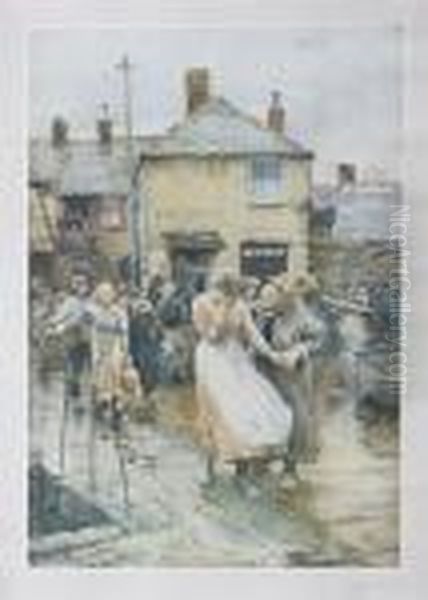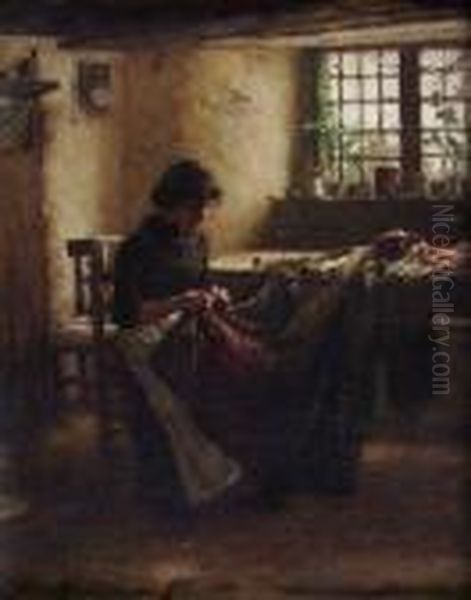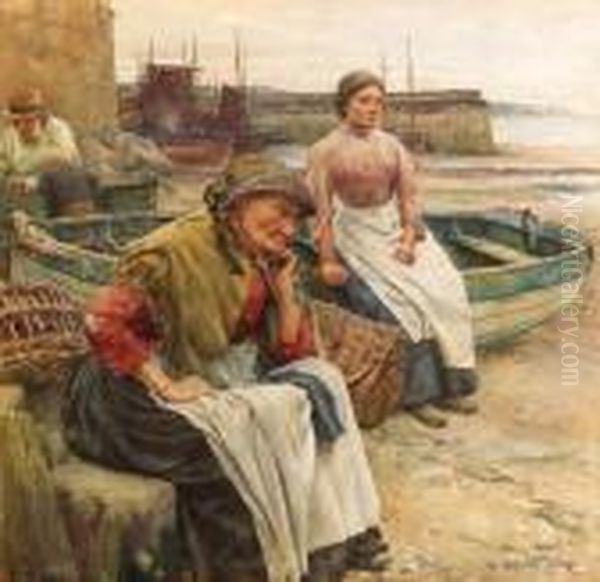Walter Langley stands as a significant figure in late Victorian British art, primarily recognised as one of the foundational artists of the influential Newlyn School. Born in Birmingham on June 8, 1852, and passing away in Penzance on March 21, 1922, Langley dedicated much of his artistic career to depicting the lives, labours, and emotional landscapes of the fishing communities in Cornwall. His work, predominantly executed in watercolour during his most influential period, is celebrated for its profound empathy, technical skill, and unflinching engagement with social realism, offering a poignant window into the hardships and resilience of working-class life at the turn of the century.
Early Life and Artistic Formation in Birmingham
Walter Langley's origins were rooted in the industrial heartland of England. Born into a working-class family in Birmingham, his early life was shaped by the realities of urban industrial society. This background likely fostered the deep sense of empathy for the labouring classes that would become a hallmark of his later work. His artistic talents emerged early, leading him to pursue formal training.
He initially studied design at the South Kensington School of Art in London, having secured a scholarship at the age of 21. His studies there, spanning two years, focused on decorative arts, including work in gold and silver, and design principles often associated with the Gothic Revival style prevalent at the time. This foundational training in design instilled in him a meticulous attention to detail and composition that would remain evident throughout his painting career.
Following his studies in London, Langley returned to Birmingham. He initially worked as a lithographer, a trade that further honed his draughtsmanship and understanding of tonal values. However, his passion lay in painting, and he continued to develop his skills, particularly in watercolour, a medium in which he would achieve remarkable proficiency and early recognition. His Birmingham roots connected him to a city with a burgeoning artistic scene, influenced by figures associated with the Birmingham School, though Langley would soon forge his own distinct path.
The Move to Newlyn: A Defining Moment

A pivotal moment in Langley's career occurred around 1881-1882. A commission from a Birmingham-based photographer, identified as Mr. Thrupp, required him to travel to the small fishing village of Newlyn, situated on the coast of Cornwall in the far southwest of England. This commission provided the impetus and financial means for Langley to relocate permanently. He moved with his family, becoming one of the very first artists to settle in what would soon become a famous art colony.
Newlyn, with its dramatic coastal scenery, unique quality of light, and close-knit fishing community, offered Langley a wealth of subject matter that resonated deeply with his artistic and social sensibilities. He was captivated by the daily lives of the fisherfolk – their perilous work at sea, the anxieties of the families left ashore, the camaraderie, the poverty, and the quiet dignity in the face of adversity.
His arrival marked the nascent beginnings of the Newlyn School. While artists like Stanhope Forbes are often credited with consolidating the group's identity slightly later, Langley's presence from the outset established him as a true pioneer. He set up his studio and began meticulously documenting the world around him, laying the groundwork for a movement defined by its commitment to realism and painting scenes of local, everyday life, often out-of-doors (plein air), though Langley himself frequently worked up his detailed watercolours indoors from sketches.
The Newlyn School: Context and Contemporaries
The Newlyn School emerged as a significant force in British art during the 1880s and 1890s. It represented a move away from the highly finished, often sentimental or historical subjects favoured by the academic establishment, towards a more direct, truthful depiction of contemporary rural life. The artists were drawn to Cornwall's unique light and the perceived authenticity of the fishing communities, seeing in them subjects worthy of serious artistic treatment.
Langley was soon joined by a growing number of talented artists who shared similar aims. Key figures included Stanhope Forbes and his wife Elizabeth Forbes (née Armstrong), Frank Bramley, Thomas Cooper Gotch, Henry Scott Tuke, Norman Garstin, Edwin Harris, Harold Harvey, and later figures associated with the colony like Laura Knight and Harold Knight. These artists, while diverse in their individual styles, were united by their interest in realism, the effects of natural light, and subject matter drawn from the local environment.

The movement drew inspiration from French realist painters like Jules Bastien-Lepage and the Barbizon School painters such as Jean-François Millet, who had similarly focused on rural labour and peasant life. The Newlyn artists adapted these influences to a distinctly British context, capturing the specific atmosphere and social fabric of the Cornish coast. Langley, alongside Stanhope Forbes and Frank Bramley, became particularly known for the social realist dimension of his work, focusing on the human drama within the community.
Artistic Style: Watercolour Mastery and Social Realism
Walter Langley's artistic style is characterised by its technical virtuosity, particularly in watercolour, and its powerful emotional resonance. For much of his early and middle career, watercolour was his primary medium. He developed a remarkable command over it, using techniques that allowed for both fine detail and broad, atmospheric effects. His handling was often described as simple, direct, and exquisite, demonstrating a deep understanding of the medium's capabilities.
His watercolours are noted for their rich tonal depth and subtle colour harmonies, often employing a relatively subdued palette that suited the frequently sombre or poignant themes he depicted. He masterfully captured the textures of worn clothing, weathered faces, fishing nets, and cottage interiors, grounding his figures firmly in their environment. His training in design is evident in the careful composition of his works, guiding the viewer's eye and enhancing the narrative impact.
While celebrated for his watercolours, Langley began working more frequently in oil paint from around 1892 onwards. Though oil allowed for greater textural possibilities and perhaps appealed more to the exhibition standards of the time, his fundamental approach remained consistent. Whether in watercolour or oil, his work was underpinned by a commitment to realism – not merely photographic accuracy, but a deeper truthfulness to the emotional and social realities of his subjects' lives. His style carried a strong element of social commentary, highlighting the hardships and quiet heroism of ordinary people. This aligns him with other British social realists of the period, such as Hubert von Herkomer and Luke Fildes.
Themes of Labour, Loss, and Resilience
The dominant themes in Walter Langley's art revolve around the lives of the Newlyn fishing community. He depicted fishermen preparing their nets, boats setting out to sea or returning to harbour, and market scenes. However, he was particularly drawn to the human cost of this dangerous livelihood, focusing especially on the experiences of the women and families left behind.

His work often explores themes of anxiety, waiting, loss, and endurance. He portrayed women mending nets, gazing out to sea for returning boats, comforting children, or mourning loved ones lost to the waves. These depictions challenged conventional Victorian representations of women, highlighting their strength, resilience, and central role in the community's social and economic fabric. Indeed, women often became the primary 'breadwinners' when men were away at sea or tragically did not return.
Langley's working-class background and reported socialist sympathies informed his choice of subject matter. He was not merely an observer but an empathetic chronicler of the struggles faced by the poor and labouring classes. His paintings often carry a palpable sense of pathos, inviting viewers to contemplate the harsh realities of life for those dependent on the unpredictable sea. Yet, his work avoids overt sentimentality, instead conveying a profound respect for the dignity and fortitude of his subjects. His connection with social radicals like Charles Bradlaugh underscores the political dimension that subtly informs his compassionate portrayal of working lives.
Representative Works: Narratives in Paint
Several key works exemplify Walter Langley's style and thematic concerns:
Men Must Work and Women Must Weep: Perhaps Langley's most famous watercolour, this title is borrowed directly from a line in Charles Kingsley's poem "The Three Fishers" (1851), which laments the dangers faced by fishermen and the sorrow of the women left behind. The painting typically depicts a cottage interior where a woman, often elderly, confronts the grief and anxiety associated with the perilous life of the fishermen in her family. The work is renowned for its emotional power, detailed execution, and poignant atmosphere, capturing a universal theme of loss and waiting. It cemented Langley's reputation as a master of narrative watercolour.
The Breadwinners (1896): This painting, likely an oil work exhibited at the Royal Academy, directly addresses the vital economic role of women in the fishing community. It portrays the hard-working fishwives (or 'fish jousters') who processed, carried, and sold the fish caught by the men. The title itself is a powerful statement about their contribution and the burdens they carried, particularly when male family members were lost or unable to work. It reflects Langley's focus on social realities and the often-overlooked labour of women.
Between the Tides: Another well-known work, often depicting figures on the shoreline during the interval between high and low tide. This setting, the liminal space between land and sea, was frequently used by Langley and other Newlyn painters. Such scenes could capture moments of work (gathering bait, mending nets), quiet contemplation, or anxious waiting, embodying the community's intimate and often precarious relationship with the ocean. Its popularity is attested by strong results when works with this title appear at auction.
Among the Missing: This title, used for more than one work, starkly conveys the ever-present danger of life at sea. Paintings with this theme often show a family receiving news of a lost boat or scanning lists of survivors, capturing moments of intense grief and uncertainty. These works are among Langley's most emotionally charged, directly confronting the tragic dimension of the fishing industry.
Old Newlyn Quay: Langley frequently depicted the harbour and quay, the bustling heart of the community. Works like Old Newlyn Quay capture the daily activity – boats moored, fishermen at work, baskets of fish – providing a detailed, atmospheric snapshot of the village's maritime life. These scenes showcase his skill in rendering complex compositions and capturing the specific light and weather conditions of the Cornish coast.
Other works, such as Departure of the Fleet for the North or scenes set within humble cottage interiors showing moments of quiet domesticity or sorrow, further elaborate on his central themes, consistently demonstrating his empathetic eye and technical skill.
Influences and Artistic Connections
Walter Langley's art was shaped by various influences and connections. His early training in design provided a strong foundation, while his move to Newlyn immersed him in the burgeoning realist movement fostered there. The shared ethos of the Newlyn School artists, particularly Stanhope Forbes, Frank Bramley, and Thomas Cooper Gotch, undoubtedly created a stimulating environment, although Langley maintained a distinct focus, especially through his mastery of watercolour.
The influence of French realism, particularly Jules Bastien-Lepage, is often cited in relation to the Newlyn School's commitment to plein air painting and truthful depiction of rural subjects. While Langley absorbed these trends, his work retained a uniquely British sensibility, perhaps closer in spirit to the social commentary found in the work of Victorian painters like Hubert von Herkomer or Luke Fildes, or even earlier precedents in Dutch Golden Age painting by artists like Rembrandt or Jan Steen, known for their intimate portrayals of everyday life.
Literary influences, such as Charles Kingsley's poetry, provided direct inspiration for specific works and resonated with the broader themes of social concern and the human condition that Langley explored. His engagement with contemporary social and political issues, reflected in his support for figures like Charles Bradlaugh, also informed the compassionate and critical perspective evident in his art. He was part of a wider Victorian conversation about poverty, labour, and social justice, using his art as a medium for commentary.
Reception, Recognition, and Legacy
Despite being a pioneer of the Newlyn School and a master watercolourist, Walter Langley's critical reception during his lifetime was somewhat complex. Watercolour was often considered a less prestigious medium than oil painting by the art establishment, particularly the Royal Academy. This perception may have initially limited his recognition compared to contemporaries like Stanhope Forbes, who worked predominantly in oil and achieved significant academic success.
Nevertheless, Langley did achieve considerable acclaim. He was elected an Associate of the Royal Birmingham Society of Artists (RBSA) in 1881 and a full member in 1884. He became an Associate of the Royal Institute of Painters in Water Colours (RI) in 1883 and a full member later. His work was exhibited regularly, including at the Royal Academy (especially after he took up oils more seriously). His paintings were admired for their technical skill and emotional depth.
International recognition came when one of his watercolours was purchased for the Uffizi Gallery in Florence, a significant honour. Furthermore, his work reportedly earned praise from the renowned Russian novelist Leo Tolstoy, who admired its truthful portrayal of human life and labour. These accolades indicate that his talent and the power of his social realist vision were acknowledged beyond British shores.
In recent decades, there has been a growing appreciation for Langley's contribution to British art. Art historians recognise his crucial role in the early development of the Newlyn School and his mastery of watercolour. His works are held in major public collections, including Birmingham Museum and Art Gallery, Penlee House Gallery & Museum in Penzance, and the Victoria and Albert Museum in London. His paintings continue to command interest in the art market, valued for their historical significance, artistic quality, and enduring human appeal.
Conclusion: An Enduring Vision
Walter Langley remains a pivotal figure in the narrative of British art at the end of the 19th century. As a founding member of the Newlyn School, he helped steer a course towards realism, focusing attention on the lives of ordinary working people in Cornwall. His exceptional skill as a watercolourist allowed him to convey profound emotion and intricate detail, creating works that are both aesthetically compelling and deeply moving.
His legacy lies in his compassionate and unflinching portrayal of the fishing community of Newlyn. Through his art, he gave voice to their struggles, highlighted their resilience, and captured the universal human experiences of labour, loss, love, and endurance. While perhaps sometimes overshadowed by his oil-painting contemporaries during his lifetime, Walter Langley's work endures as a powerful testament to the dignity of everyday life and the capacity of art to illuminate the social and emotional landscapes of its time. His paintings continue to resonate with audiences today, offering a poignant and historically significant glimpse into a world shaped by the rhythms of the sea.